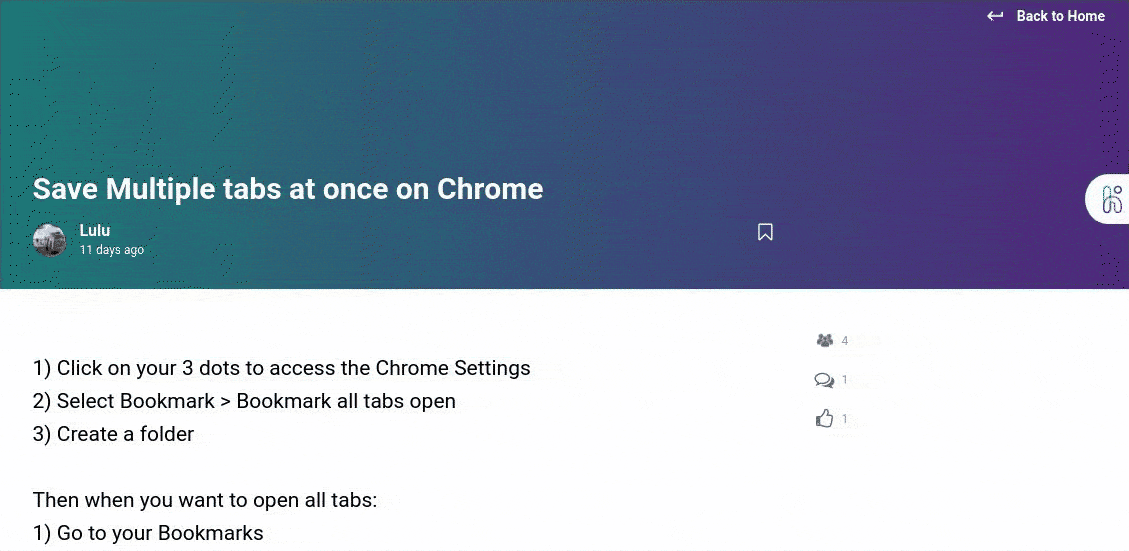Using a knowledge base always feels like a bit of an anti-climax, doesn’t it?
Or at least it does in the way most companies currently use it.
Best case, you search through the library of resources, find the answers you’re looking for, and go apply it!
Where’s the opportunity to interact? To ask a question on that topic, share your experience or start a discussion.
People typically use knowledge bases to complete a task or respond to customers more effectively, and it makes sense that they’d have thoughts on the knowledge they’re applying in those situations.
If they can’t share those, then any customer feedback or insightful employee additions that might improve the resource slip through the net.
The clue’s in the name, this should be your base for knowledge and you should build on it over time!
The issue is often that permissions on who can edit or upload content are limited to a select few. But do they always know best? Shouldn’t everyone be able to chuck in their two cents, especially on the topics they’re dealing with every day? They should, which is why you need something that’s made for sharing.
Yes! If you’re interested in democratising knowledge sharing and giving everyone a voice. Unlike knowledge bases, learning and knowledge sharing platforms enable everyone to contribute to an ever-growing content library and create meaningful discussions around these issues.
They’re built for sharing, collaborating and creating a knowledge-sharing culture, and here are some of the key reasons that’s so valuable.
When your internal experts are adding knowledge, people are not only learning from the best in the business, they know who to discuss the issue with now and in the future.
Knowledge management is about capturing all the useful, contextual insights from internal experts. That way, knowledge is no longer lost, it's centralised and available to everyone.
In HowNow, we take that a step further with our Discussion feature.
This allows your people to start a conversation directly within that resource. Whether that leads to the content being updated or simply adds context to anyone else who has similar questions, it’s invaluable for building a living, context-driven knowledge base.

Learning platforms are great for tapping into your best minds without pestering them on a regular basis. Nobody likes repeating themself, but if they’ve got a platform to upload a response to something they’re frequently asked then it cuts back on the need for repeat questions. Because they only need to answer it once, it ensures that the answer people get is consistent and high-quality. You’re also giving people the opportunity to send that content to anyone they feel would benefit from seeing it!
When new people join your company, their fresh perspective could be exactly what your content library needs. If they can comment when resources aren’t clear, highlight any questions that were unanswered and connect with internal experts, that’s a win-win situation. There’s still the self-service approach to finding information that you’d get with a knowledge base, it’s just that newbies have a person and place to direct their questions. Knowing who to ask can be a daunting experience when you’re onboarding.
While knowledge bases can be a bit of closed shop when it comes to integrating with other software, HowNow plays much better with others. This means that you can find and share your knowledge and resources in the workflow and apps you’re already using. Gone are the days of heading to a separate platform for the content you need, you should be able to find it right where you are.
To answer our original question, if a knowledge base was made for sharing and collaborating it would look a lot like HowNow! We’ll help you collect knowledge, share it and learn in the flow of work. You can find more about us here or see our platform in action by signing up for a tour.
On paper, this sounds good. But how does this actually work in practice?
We hear you, and that's why we're sharing a very simple playbook from Gymshark.
They built their knowledge sharing on two simple principles.
1. Empower everyone in their support team to capture knowledge.
2. Make sure answers to repeat questions were captured.
Hit play to learn how Gymshark used HowNow as their collaborative knowledge base.
It's as simple as: If I ask the same question twice, I need to capture an answer to it.
Why? Because it gives everyone access to consistent high quality information from an internal expert, and ensures those internal experts aren't asked the same question over and over.
And they gave everyone in the support team the capacity to create Nuggets - ensuring everyone could contribute to the collaborative knowledge base.
However, this is another side to this coin - how do you stop yourself ending up with a content landfill, rather than that lean bank of useful resources.
The answer is to set guidelines and guiding principles for using the collaborative knowledge base. Simple things like, check if something exists before you add something new - to prevent duplicates and uncertainty when people use it.
%20(1).webp)